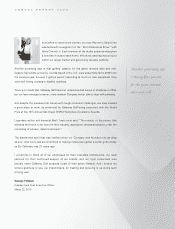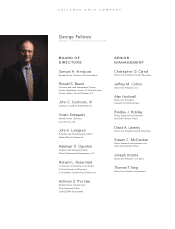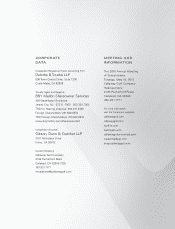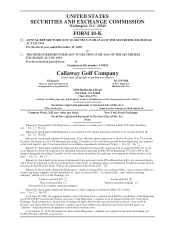Callaway 2009 Annual Report Download - page 17
Download and view the complete annual report
Please find page 17 of the 2009 Callaway annual report below. You can navigate through the pages in the report by either clicking on the pages listed below, or by using the keyword search tool below to find specific information within the annual report.Manufacturing
In connection with the Company’s gross margin improvement initiatives, the Company has aggressively
moved its production capabilities for both golf clubs and golf balls to other locations and to third parties outside
the United States in order to meet regional demand and reduce costs. As a result, during 2009, more than half of
the Company’s golf club and golf ball production volume was generated at third-party sites outside the United
States. The Company continues to produce a significant amount of its golf clubs and golf balls at its facilities in
Carlsbad, California and Chicopee, Massachusetts, respectively.
In general, the Company’s golf clubs are assembled using components obtained from suppliers both
internationally and within the United States. Significant progress has been made in automating certain facets of
the manufacturing process during the last few years and continued emphasis will be placed on automated
manufacturing by the Company. However, the overall golf club assembly process remains fairly labor intensive,
and requires extensive global supply chain coordination. With respect to golf balls, although a significant amount
of labor is still used, the overall manufacturing process is much more automated than the golf club assembly
process.
The Company purchases raw materials from numerous domestic and international suppliers in order to meet
scheduled production needs. Raw materials include steel, titanium alloys and carbon fiber for the manufacturing
of golf clubs, and rubber, plastic ionomers, zinc sterate, zinc oxide and lime stone for the manufacturing of golf
balls. For certain risks associated with golf club and golf ball manufacturing, see below, “Certain Factors
Affecting Callaway Golf Company” contained in Item 1A.
Sales and Marketing
Sales in the United States
Approximately 50% of the Company’s net sales were derived from sales within the United States in both
2009 and 2008, and approximately 53% in 2007. The Company primarily sells to both on- and off-course golf
retailers and sporting goods retailers who sell quality golf products and provide a level of customer service
appropriate for the sale of such products. The Company also sells certain products to mass merchants. On a
consolidated basis, no one customer that distributes golf clubs or golf balls in the United States accounted for
more than 6% of the Company’s consolidated revenues in 2009, 5% in 2008 and 3% in 2007. On a segment
basis, the golf ball customer base is much more concentrated than the golf club customer base. In 2009, the top
five golf ball customers accounted for approximately 22% of the Company’s total consolidated golf ball sales. A
loss of one or more of these customers could have a significant adverse effect upon the Company’s golf ball
sales.
Sales of the Company’s products in the United States are made and supported by full-time regional field
representatives and in-house sales and customer service representatives. Most of the Company’s geographic
territories are covered by both a field representative and a dedicated in-house sales representative who work
together to initiate and maintain relationships with customers through frequent telephone calls and in-person
visits. In addition to these sales representatives, the Company also has dedicated in-house customer service
representatives.
In addition, other dedicated sales representatives provide service to corporate customers who want their
corporate logo imprinted on the Company’s golf balls, putters or golf bags. The Company imprints the logos on
the majority of these corporate products, thereby retaining control over the quality of the process and final
product. The Company also pays a commission to certain on-and off-course professionals and retailers with
whom it has a relationship for corporate sales that originate through such professionals and retailers.
The Company also has a separate team of club fitting specialists who focus on the Company’s custom club
sales. Custom club sales are generated primarily from the utilization of the Company’s club fitting programs such
as performance centers, which utilize high speed cameras and precision software to capture relevant swing data.
4
























